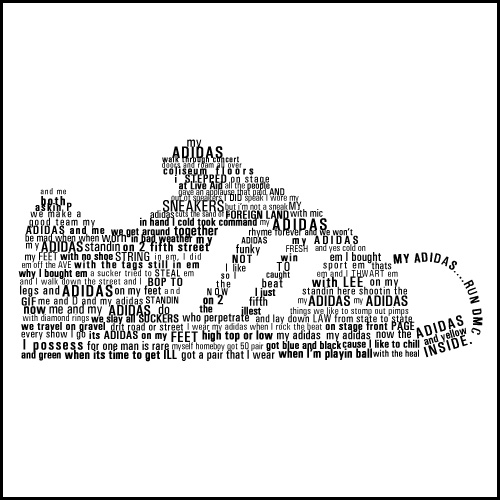ADIDAS WAS FOUNDED IN 1924 AS GRUBRUDER DASSLER SCHUHFABRIK AND WAS REGISTERED IN 1949
Adidas is a German-based sports apparel manufucturer. Along with footwear Adidas also produces clothing, bags, watches, eyewear and other sports related apparel. Along with Nike, Adidas is the 2nd largest sporstwear manufacturer in the world.
Celebrities that wear Adidas include Run-DMC, NFL Star Reggie Bush, Missy Elliot, Lil Wayne, Drake, Ludacris and Ciara
Adolf "Adi" Dassler
Adidas is a German-based sports apparel manufucturer. Along with footwear Adidas also produces clothing, bags, watches, eyewear and other sports related apparel. Along with Nike, Adidas is the 2nd largest sporstwear manufacturer in the world.
Celebrities that wear Adidas include Run-DMC, NFL Star Reggie Bush, Missy Elliot, Lil Wayne, Drake, Ludacris and Ciara
Adolf "Adi" Dassler
Adolf "Adi" Dassler (born 5 November 1900 in Herzogenaurach, Kingdom of Bavaria, German Empire; died 6 September 1978 in Herzogenaurach, West Germany) was the founder of the Germansportswear company Adidas.
Trained as a cobbler, Adi Dassler started to produce his own sports shoes in his mother's laundry after his return from World War I. His father, Christoph, who worked in a shoe factory, and the Zehlein brothers, who produced the handmade spikes for track shoes in their blacksmith's shop, supported Dassler in starting his own business. On July 1, 1924, his older brother Rudolf Dassler joined the business, which became the Gebrüder Dassler
Gebrüder Dassler Schuhfabrik
By the 1936 Summer Olympics, Adi Dassler drove from Bavaria on one of the world's first motorways to the Olympic village with a suitcase full of spikes and persuaded U.S. sprinter Jesse Owens to use them, the first sponsorship for an African American. Following Owens's haul of four gold medals, his success cemented the good reputation of Dassler shoes among the world's most famous sportsmen. Letters from around the world landed on the brothers' desks, and the trainers of other national teams were all interested in their shoes. Business boomed and the Dasslers were selling 200,000 pairs of shoes each year before World War II.
Late in World War II, the shoe factory shifted to production of the Panzerschreck anti-tank weapon.
Company split
Both brothers joined the Nazi Party, but Rudolf was slightly closer to the party. During the war, a growing rift between the pair reached a breaking point after an Allied bomb attack in 1943 when Adi and his wife climbed into a bomb shelter that Rudolf and his family were already in: "The dirty bastards are back again," Adi said, referring to the Allied war planes, but Rudolf was convinced his brother meant him and his family.[10] After Rudolf was later picked up by American soldiers and accused of being a member of the Waffen SS, he was convinced that his brother had turned him in.[7]
The Tapie affair
After a period of trouble following the death of Adolf Dassler's son Horst Dassler in 1987, the company was bought in 1989 by French industrialist Bernard Tapie, for ₣1.6 billion (now €243.918 million), which Tapie borrowed. Tapie was at the time a famous specialist of rescuing bankrupt companies, an expertise on which he built his fortune.
Tapie decided to move production offshore to Asia. He also hired Madonna for promotion. He sent, from Christchurch, New Zealand, a shoe sales representative to Germany and met Adolf Dassler's descendants (Amelia Randall Dassler and Bella Beck Dassler) and was sent back with a few items to promote the company there.
In 1992, unable to pay the loan interest, Tapie mandated the Crédit Lyonnais bank to sell Adidas, and the bank subsequently converted the outstanding debt owed into equity of the enterprise, which was unusual as per the prevalent French banking practice. The state-owned bank had tried to get Tapie out of dire financial straits as a personal favour to Tapie, it is reported, because Tapie was Minister of Urban Affairs (ministre de la Ville) in the French government at the time.
In February 1993, Crédit Lyonnais sold Adidas to Robert Louis-Dreyfus, a friend of Bernard Tapie for a much higher amount of money than what Tapie owed, 4.485 billion (€683.514 million) francs rather than 2.85 billion (€434.479 million). Tapie later sued the bank, because he felt "spoiled" by the indirect sale.
Robert Louis-Dreyfus became the new CEO of the company. He was also the president of Olympique de Marseille, a team Tapie had owned until 1993.
Tapie filed for personal bankruptcy in 1994. He was the object of several lawsuits, notably related to match fixing at the football club. During 1997, he served 6 months of an 18-month prison sentence inLa Santé prison in Paris. In 2005, French courts awarded Tapie a €135 million compensation (about 886 million francs)
Post—Tapie era
In 1994, combined with FIFA Youth Group, SOS Children's Villages became the main beneficiary.
In 1997, Adidas AG acquired the Salomon Group who specialized in ski wear, and its official corporate name was changed to Adidas-Salomon AG because with this acquisition Adidas also acquired the Taylormade Golf company and Maxfli, which allowed them to compete with Nike Golf.
In 1998, Adidas sued the NCAA over their rules limiting the size and number of commercial logos on team uniforms and apparel. Adidas withdrew the suit, and the two groups established guidelines as to what three-stripe designs would be considered uses of the Adidas trademark.
In 2003, Adidas filed a lawsuit in a British court challenging Fitness World Trading's use of a two-stripe motif similar to Adidas's three stripes. The court ruled that despite the simplicity of the mark, Fitness World 's use was infringing because the public could establish a link between that use and Adidas's mark.[12]
In September 2004, top English fashion designer Stella McCartney launched a joint-venture line with Adidas, establishing a long-term partnership with the corporation. This line is a sports performance collection for women called "Adidas by Stella McCartney",[13] and it has been critically acclaimed.[14]
Also in 2005, on 3 May, Adidas told the public that they sold their partner company Salomon Group for €485m to Amer Sports of Finland. In August 2005, Adidas declared its intention to buy British rival Reebok for $3.8 billion (US$). This takeover was completed with partnership in January 2006[1] and meant that the company would have business sales closer to those of Nike in North America. The acquisition of Reebok would also allow Adidas to compete with Nike worldwide as the number two athletic shoemaker in the world.[15]
Adidas has global corporate headquarters in Germany, and many other business locations around the world such as Portland OR, Hong Kong, Toronto, Taiwan, England, Japan, Australia, and Spain. Mainly sold in the U.S., Adidas makes lots of assets from these countries and is expanding to more oversea countries.
In 2005, Adidas introduced the Adidas 1, the first ever production shoe to utilize a microprocessor. Dubbed by the company "The World's First Intelligent Shoe", it features a microprocessor capable of performing 5 million calculations per second that automatically adjusts the shoe's level of cushioning to suit its environment. The shoe requires a small, user-replaceable battery that lasts for approximately 100 hours of running. On 25 November 2005, Adidas released a new version of the Adidas 1 with an increased range of cushioning, allowing the shoe to become softer or firmer, and a new motor with 153 percent more torque.
On 11 April 2006, Adidas announced an 11-year deal to become the official NBA apparel provider. They will make NBA, NBDL, and WNBA jerseys and products as well as team-coloured versions of the "Superstar" basketball shoe. This deal (worth over $400 million) takes the place of the previous 10-year Reebok deal that was put in place in 2001.
Run-DMC takes Adidas to a whole new level
Adidas was made even more popular in the 80's by hip hop superstars, Run-DMC. They also have a song:
"My Adidas" from their 1986 album Raising Hell
Adidas Slogan
"Impossible is Nothing"
1950's
1960's
1970's
1980's
A TASTE OF OUR ADIDAS IN STORE






















